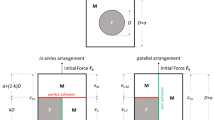Abstract
An equation recently developed by the present author to describe the modulus of particulate composites as a function of the volume fraction of particles was modified in this study to describe modulus as a function of porosity. This new equation was applied to available modulus literature for ceramics where voids were the particulate phase. By varying the porosity interaction coefficient, σ, this new generalized void/modulus equation was shown to be able to yield equations previously used to predict modulus as a function of voids for ceramics. Wang theoretically described the mode of porosity interaction during compaction with a constant, α, to calculate the void/modulus relationship for three different compaction conditions. The generalized void/modulus equation developed in this study fit Wang's theoretical data exceptionally well, even though the porosity interaction coefficients, σ, obtained did not agree closely with Wang's values of α. Wang also experimentally measured the porosity and Young's modulus of manufactured alumina rods prepared with spherical and “egg-shaped” powders. The optimum fit for spherical particles occurred at σ=0.9 and an initial porosity of P i=0.405 and for “egg-shaped” particles at σ=1.05 and P i=0.475. The generalized void/modulus the equation for σ=−1 yields an equation that has the same form as Wang's proposed empirical equation that utilized two empirical constants, b and c. Wang's experimental data fitted with his proposed empirical equation gave a positive value for the constant c of 0.982 which corresponded to a negative value of P i of -0.0743 which was not defined in the theoretical considerations developed in this study. While this value of the initial porosity, P i, does give a better fit of the data for the interaction constant σ=-1, it still did not fit all the data as well as the results calculated for interaction coefficients nearer 1.0. The results of this study have shown that an excellent fit of most void/modulus data can be obtained using the generalized void/modulus equation developed in this study without making assumptions inconsistent with the theory presented.
Similar content being viewed by others
References
R. L. Coble and W. D. Kingery, J. Am. Ceram. Soc. 39 (1956) 377.
Eugene Ryshkewitch, ibid. 36 (1953) 65.
F.P. Knudsen, ibid. 42 (1959) 376.
J. C. Wang, J. Mater. Sci. 19 (1984) 801.
Idem, ibid. 19 (1984) 809.
J.K. Mackenzie, Proc. Phys. Soc. (Lond.) 63B (1) (1950) 2.
F. Gatto, Allumino 19 (1) (1950) 19.
R. M. Spriggs, J. Am. Ceram. Soc. 44 (1961) 628.
F. P. Knudsen, ibid. 45 (2) (1962) 94.
I. Soroaka and P. J. Sereda, ibid. 51 (1968) 337.
R. D. Carnahan, ibid. 51 (1968) 223.
D. F. Porter, J. S. Reed and David Lewis III, ibid. 60 (1977) 345.
D. P. H. Hasselman, ibid. 45 (1962) 452.
K. K. Phani, and S.K. Niyogi, J. Mater. Sci. 22 (1987) 257.
B. D. Agarwal, G. A. Panizza and L. J. Broutman, J. Am. Ceram. Soc. 54 (1971) 620.
Richard D. Sudduth, J. App. Polym. Sci. 48 (1993) 25.
Idem, ibid. 48 (1993) 37.
Idem, ibid. 50 (1993) 5.
Idem, ibid. 52 (1994) 985.
Idem, ibid. 54 (1994) 1243.
R. K. Mcgeary J. Am. Ceram. Soc. 44 (1961) 513.
Do Ik Lee, J. Paint Technol. 42 (1970) 579.
George E. Dieter, “Mechanical Metallurgy” 2nd Edn (McGraw Hill, New York, (1976) p. 51.
A. Einstein, Ann. Phys. 19 (1906) 289.
Idem, ibid. (1911) 591.
D. C. Drucker, “Introduction to Mechanics of Deformable Solids” (McGraw Hill, New York, (1967) pp. 64–5.
B. J. Budiansky, J. Mech. Phys. Solids. 13 (1965) 223.
Jack C. Smith, J. Res. Nat. Bur. Stand. 78A (1974) 355.
C. Van Der Poel, Rheol. Acta 1 (1958) 198.
E. H. Kerner, Proc. Phys. Soc. B69 (1956) 808.
Z. Hashin and S. J. Shtrikman, J. Mech. Phys. Solids 11 (1963) 127.
Author information
Authors and Affiliations
Rights and permissions
About this article
Cite this article
Sudduth, R.D. A generalized model to predict the effect of voids on modulus in ceramics. JOURNAL OF MATERIALS SCIENCE 30, 4451–4462 (1995). https://doi.org/10.1007/BF00361531
Received:
Accepted:
Issue Date:
DOI: https://doi.org/10.1007/BF00361531




